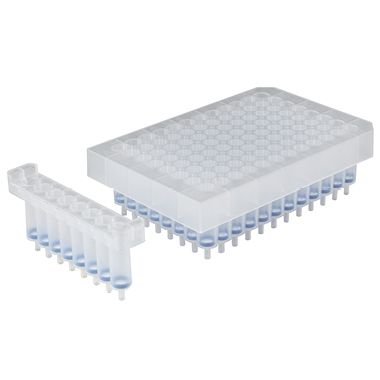NucleoSpin 8 / 96 RNA Blood
NucleoSpin 8 / 96 RNA Blood
Isolation of total RNA from whole blood (human or animal) – flexible 8-well strip format for varying throughput or proven 96-well format for high throughput
Applications
- Isolation of RNA from fresh or frozen whole blood from common blood collection tubes (EDTA, citrate, heparin)
- Typical downstream applications: qRT-PCR, next generation sequencing, blotting, array technology
Features
- Direct total blood lysis – very simple and convenient procedure (patent pending)
- No selective erythrocyte lysis at 4 °C – complete processing at room temperature
- Superior RNA yield and quality from up to 1.3 mL whole blood
- Efficient on-column DNA removal for an increased sensitivity in downstream applications
- Compatible with common blood collection tubes and anticoagulants (e.g., EDTA, citrate, and heparin)
Specifications
- Technology: Silica membrane technology
- A260/A280: 1.9–2.1
- Fragment size: > 200 nt
NucleoSpin® 8 RNA Blood
- Processing: Manual or automated
- Sample material: < 400 μL blood
- Typical yield: Blood (400 μL): 1–8 μg*
- Elution volume: 50–130 μL
- Binding capacity: 100 μg
- Processing time: 60 min/48 preps
NucleoSpin® 96 RNA Blood
- Processing: Manual or automated
- Sample material: < 400 μL blood
- Typical yield: Blood (400 μL): 1–8 μg*
- Elution volume: 50–130 μL
- Binding capacity: 100 μg
- nn Processing time: 100 min/96 preps
Effective DNA removal

Effective DNA removal. Total RNA was isolated manually under vacuum from 400-µl whole blood samples (EDTA) according to the standard protocol for NucleoSpin 96 RNA Blood, with and without an on-column rDNase treatment. A PCR for human elongation factor EF-1a was performed to determine the amount of residual genomic DNA in the eluted RNA using a LightCycler system and gene-specific primers designed to yield a 469-bp product. The figure shows the corresponding amplification curves of the 0.01 ng–100 ng DNA standards (dark blue lines), the NTC (negative control; green), and replicates of the blood sample 1 (1-1, 1-2), with DNase treatment (+ DNase; red lines) and without DNase treatment (-DNase; light blue lines). In total, blood samples from six individual donors were analyzed by PCR (data not shown). Samples treated with rDNase (+DNase) show an average Cp of 31.8. Samples purified without rDNase (-DNase) treatment show an average Cp of 25.9. Omitting the on-column DNA digestion results in an approximately 64 times higher amount of residual gDNA.
Consistent RNA quality from fresh or frozen blood samples

Consistent RNA quality from fresh or frozen blood samples. NucleoSpin 96 RNA Blood was used to isolate RNA in triplicate from 400-µl fresh or frozen blood (EDTA) samples obtained from six different donors under vacuum. Frozen sample aliquots had been stored at –20°C. RNA quality was determined by spectrophotometric measurement of absorption at 260 nm and 280 nm.
Consistent RNA yield from fresh or frozen blood samples

Consistent RNA yield from fresh or frozen blood samples. NucleoSpin 96 RNA Blood was used to isolate RNA in triplicate from 400-µl fresh or frozen blood (EDTA) samples obtained from six different donors under vacuum. Frozen sample aliquots had been stored at –20°C. RNA yield was determined by spectrophotometric measurement of absorption at 260 nm and 280 nm.


